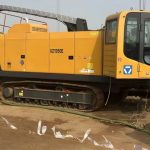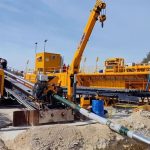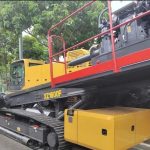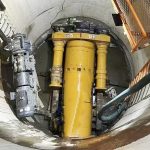Categories
Latest Updates





What are the methods of trenchless pipeline detection? How should it be applied?
Detection method selection
According to the detection task and purpose, combined with the field survey and field working conditions, the geophysical prospecting method of this project is selected.
Metal pipelines generally have a medium strength or above (the K value is generally 100×4π×SI~1000×10-6×4π×SI), and its resistivity is generally 0.23×10-4ΩM~0.89×10-4ΩM. Good conductivity and magnetic permeability. Underground pipelines are generally laid in a shallow surface soil layer within 5 meters below the surface. The surface soil layer is generally non-magnetic, and its resistivity is in the range of several ohm meters to tens of ohm meters. This shows that the underground pipeline and the surrounding medium have obvious electrical properties. , Magnetic difference. Therefore, the underground pipeline detector made with the principle of electromagnetic induction can more accurately detect the distribution of underground metal pipelines, and has the necessary geophysical premises for detection.
Applying an alternating electromagnetic field of a certain frequency and appropriate strength to the target pipeline, there is a corresponding alternating current passing between the target pipeline and the earth, and the alternating current generates an alternating electromagnetic field of the same frequency in the surrounding space, that is, in the target pipeline An abnormal secondary alternating electromagnetic field is formed around, and the receiving device is used to detect the abnormality, then the location of the target pipeline can be determined, and the purpose of detecting the underground pipeline can be achieved.
The detection methods are divided into active source and passive source methods. The active source method includes direct method, clamp method, and induction method.
Use corresponding methods according to the characteristics of various pipelines. For example, the passive source method can be used for power cables; while tracking the direction of underground pipelines or distinguishing underground pipelines, the active source method (direct method, clamp method) can be used, which is more accurate than the passive source method.
The detection of non-excavated and non-metallic pipelines with entrances and exits is to use a cable passer to penetrate a fixed frequency sensor into the hole, and use a receiver on the ground to receive the electromagnetic wave signal emitted by the sensor to determine the depth and plane position of the sensor from the ground. The buried depth and plane position of the information pipeline can be determined.
The spiral gauge is a device designed based on the theory of conservation of angular momentum. The gyroscope is mainly composed of a rotatable rotor located on the axis. Once the gyroscope starts to rotate, due to the angular momentum of the rotor, the gyroscope has a tendency to resist changes in direction.
The gyroscope and the accelerometer respectively measure the 3 angular velocities in the relative inertial space of the locator and the 3 linear acceleration components that extend the locator coordinate system. After coordinate transformation, the acceleration information is converted into the acceleration of the navigation coordinate system. And calculate the position, speed, heading and horizontal attitude of the locator. As a new underground pipeline positioning method, the three-dimensional precise positioning technology of the gyroscope has the following technical characteristics:
(1) The measurement is not restricted by terrain, depth, or electromagnetic interference;
(2) High positioning accuracy;
(3) Suitable for underground pipelines of any material;
(4) Automatically generate three-dimensional spatial curve graphs, and are seamlessly compatible with GIS;
(5) It can be used to detect large buried trenchless pipelines of various materials such as electricity, gas, water supply and drainage.
Resistivity method is to use the difference in electrical conductivity (expressed by resistivity) between different rocks in the earth’s crust, through observing and studying the distribution law of a stable electric current field artificially established underground, to achieve an electrical exploration method to solve related geological problems .
The high-density electrical method and the ultra-high-density electrical method refer to a resistivity method that uses the arrangement of electrode arrays to observe the distribution of artificially established underground stable current fields, and then can realize the detection of underground targets. The ultra-high-density electrical method has the following characteristics:
(1) First of all, the ultra-high-density electrical method breaks the limitations of data acquisition methods in conventional electrical exploration, and the use of free and unlimited combination methods to collect data is based on this ultra-high-density method that can collect dozens of times and Data that cannot be collected by conventional electrical data collection methods. For example, in the same arrangement of 64 electrodes, the conventional data collection method can only collect more than 1,000 data, but with this ultra-high-density method, more than 60,000 data can be collected. So much data greatly improves the accuracy and reliability of the inversion results. It also avoids the one-sidedness of data collection in conventional data collection methods (some focus on horizontal resolution, some focus on vertical resolution, etc.), which results in different inversion results from data collected by different data collection methods at the same location. shortcoming.
(2) Secondly, this method uses modern inversion techniques to directly invert a large amount of measured data into a true resistivity profile. This map can be directly used for the analysis and interpretation of underground rock and soil distribution and underground abnormal bodies.
(3) Another feature of this method is its 64-channel technology. For example, using conventional high-density electrical method to measure 60,000 data, it takes 3 full days, while with 64 instruments, it only takes 1 hour to collect more than 60,000 data.
The endoscope is a multi-disciplinary universal tool. Its function is to explore the depth of the curved pipe, observe the parts that cannot be directly seen, and observe the internal space structure and state in the sealed cavity, which can realize long-distance observation And operation.
The principle of the industrial endoscope is to use the transfer lens optical technology to transmit images, and the optical fiber provides light transmission and illumination. In order to transmit a clear image, the effective stainless steel insertion part of the scope is designed with a reflex lens system of several optical elements. The built-in optical fiber transmits the light to be photographed from the independent cold light source directly to the working position. The imaging is transmitted to the CCD rake surface through the objective lens, and then the CCD converts the light image into an electronic signal, and transfers the data to the video endoscope control group, which then outputs the image to the monitor or computer. . The endoscope is one of the most intuitive detection methods for observing the position of the pipeline. It has the advantages of high precision and accurate detection.
Conclusion: With the continuous expansion of the scale of cities, more and more underground pipelines are laid in a trenchless manner. Conventional underground pipeline detection methods can no longer fully meet the requirements of underground pipeline data collection. The article cited tracer electromagnetic method and inertia The gyroscope method, borehole resistivity cross-hole CT method and industrial endoscope visualization images have been applied in many projects, and good results have been confirmed.
